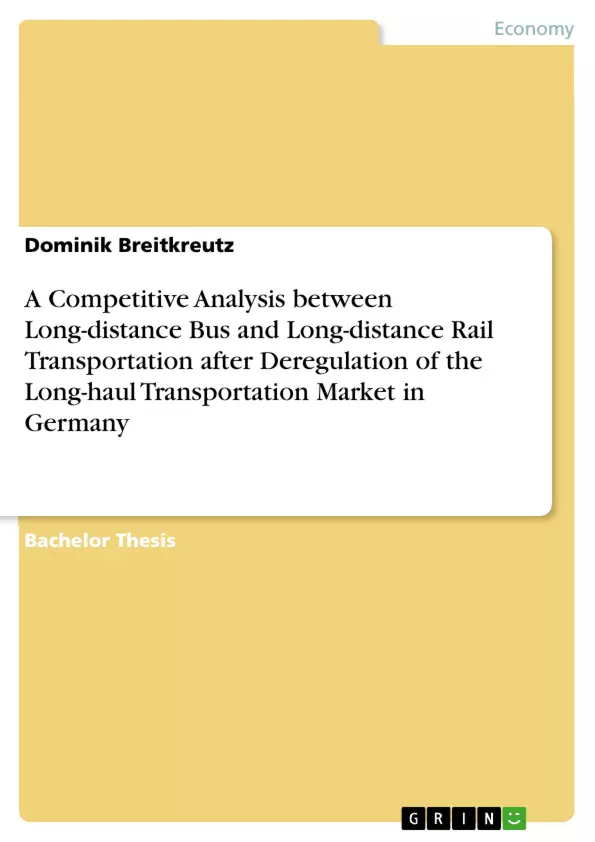Since January 2013, the long-distance transportation market in Germany has been deregulated due to the amendment of the Passenger Transport Act (Personenbeförderungsgesetz). This means that, in the future, long-distance buses may operate on routes where they were previously not allowed, to protect the interest of the railways. Following the opening up of the market in 2013, more and more long-distance bus companies have penetrated the market and a major price war has ensued. The Deutsche Bahn AG had initially underestimated the competition, and is now trying to regain passengers through elaborate mar-keting ploys.
The aim of this thesis is to compare two very different modes of transport, namely railbound long-distance transport and long-distance bus transport. Various criteria that affect the subjective trip perception of an average passenger are listed. To complete the comparison, domestic air transport is also briefly discussed, as this is also a mode of long-distance transport.
The comparison yields a differentiated view of the modes of transport and various positive and negative features can be highlighted. Nevertheless, a recommendation for or against a party is not possible in this work, as it is highly dependent on the personal preferences of the passenger. But the fact is that the various providers do not share the same competitive conditions. Till this situation is not regulated by law, a fair comparison cannot take place in any case.
Inhaltsverzeichnis (Table of Contents)
- Abstract
- Table of contents
- List of abbreviations
- List of figures
- List of tables
- Introduction and structure of work
- Problem
- Objectives and structure of the work
- Definitions of passenger transportation in Germany
- Public urban passenger transport
- Public long-distance passenger transport
- Presentation of fundamentals
- Historical development of the long-distance bus transportation
- Development of the legal framework
- Current market situation
- Environmental aspects
- Selected provider of long-distance transportation
- Long-distance railway companies
- Long-distance bus companies
- Mein Fernbus Flixbus
- Postbus
- Airlines
- Germanwings
- Air Berlin
- Interim conclusion
- Comparison of suppliers based on their offer
- Comparison of used modes of transport
- Operated trains of DB Fernverkehr AG
- Operated long-distance buses
- Operated airplanes
- Comparison of offers
- Route network
- Schedule and Travel time
- Fares
- Transaction, rebooking and cancellation fees
- Sales channels
- Comparison of service
- Comfort
- Additional offers
- Passenger information
- Passenger rights
- SWOT Analysis
- Definition
- Implementation of SWOT Analysis
- Comparison to air transport
- Benchmark Analysis
- Definition
- A Benchmark approach
- Comparison to other countries
- United Kingdom
- Sweden
- France
- Conclusion and outlook
- Declaration in lieu of oath
- List of references
- List of acts, administrative orders and regulations
- List of jurisdiction
- Appendix
- List of abbreviations
Zielsetzung und Themenschwerpunkte (Objectives and Key Themes)
This thesis aims to conduct a comparative analysis of long-distance bus and rail transportation in Germany following the deregulation of the long-haul transportation market in 2013. The study examines how this deregulation has impacted competition, consumer choice, and the overall transportation landscape in Germany. It explores the various factors that influence the subjective trip perception of passengers, including price, travel time, comfort, and service quality.
- The impact of deregulation on the long-distance transportation market in Germany.
- A comparative analysis of long-distance bus and rail transportation based on various criteria.
- The influence of consumer preferences on travel choices.
- The competitive dynamics between different transportation providers.
- The role of environmental considerations in the transportation sector.
Zusammenfassung der Kapitel (Chapter Summaries)
- Introduction and structure of work: This chapter introduces the topic of the thesis, outlining the problem of deregulation and its implications for the German transportation market. It also sets out the objectives and structure of the work.
- Definitions of passenger transportation in Germany: This chapter provides a clear definition of passenger transportation in Germany, differentiating between public urban and long-distance passenger transport.
- Presentation of fundamentals: This chapter delves into the historical development of long-distance bus transportation, examining the evolution of the legal framework governing the sector. It also discusses the current market situation and the environmental aspects of different modes of transportation.
- Selected provider of long-distance transportation: This chapter examines the key players in the long-distance transportation market, including long-distance railway companies, bus companies (such as Mein Fernbus Flixbus and Postbus), and airlines (like Germanwings and Air Berlin). It analyzes their market share, strategies, and service offerings.
- Comparison of suppliers based on their offer: This chapter compares the offerings of different transportation providers based on factors such as route network, schedule, travel time, fares, booking and cancellation fees, sales channels, comfort, additional services, passenger information, and passenger rights.
- SWOT Analysis: This chapter utilizes a SWOT analysis to assess the strengths, weaknesses, opportunities, and threats facing the long-distance transportation sector. It focuses on the impact of deregulation on the competitiveness of different providers.
- Benchmark Analysis: This chapter examines the approaches used in other countries, particularly the UK, Sweden, and France, to regulate and manage their long-distance transportation markets. It explores best practices and potential lessons for Germany.
Schlüsselwörter (Keywords)
This thesis focuses on the competitive analysis of long-distance bus and rail transportation in Germany, examining the impact of deregulation on the market. Key themes include passenger transportation, long-distance travel, deregulation, competition, consumer behavior, travel preferences, service quality, environmental considerations, SWOT analysis, and international benchmarking.
- Citar trabajo
- Dominik Breitkreutz (Autor), 2015, A Competitive Analysis between Long-distance Bus and Long-distance Rail Transportation after Deregulation of the Long-haul Transportation Market in Germany, Múnich, GRIN Verlag, https://www.grin.com/document/301752



